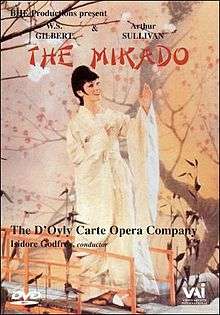The Mikado (1967 film)
| The Mikado | |
|---|---|
 Promotional poster | |
| Directed by | Stuart Burge |
| Produced by |
John Brabourne Anthony Havelock-Allan Richard B. Goodwin |
| Based on |
The Mikado by W.S. Gilbert Arthur Sullivan |
| Starring |
Valerie Masterson John Reed Kenneth Sandford Donald Adams Philip Potter |
| Music by | Arthur Sullivan |
| Cinematography | Gerry Fisher |
| Edited by | Alma Godfrey |
Production company |
BHE Films |
| Distributed by | Warner Bros. (United States) |
Release dates |
|
Running time | 122 minutes |
| Country | England |
| Language | English |
The Mikado is a 1967 musical film adaptation of Gilbert and Sullivan's comic opera of the same name. The film was directed by Stuart Burge and was a slightly cut adaptation of the D'Oyly Carte Opera Company's production of The Mikado and used all D'Oyly Carte singers.
Cast


- John Reed as Ko-Ko
- Kenneth Sandford as Pooh-Bah
- Donald Adams as the Mikado
- Valerie Masterson as Yum-Yum
- Philip Potter as Nanki-Poo
- Christene Palmer as Katisha
- Peggy Ann Jones as Pitti-Sing
- Thomas Lawlor as Pish-Tush
- Pauline Wales as Peep-Bo
- George Cook as Go-To
Production
The 1966 production of The Mikado by the D'Oyly Carte Opera Company was adapted by director Stuart Burge, who had previously adapted such films based on theatre productions as Uncle Vanya (1963) and the Laurence Olivier version of Othello (1965). The direction of the film closely reflects traditional D'Oyly Carte staging of the time by Anthony Besch, although there are some cuts.[1]
The Mikado was filmed at the Golders Green Hippodrome on enlarged stage sets. It starred John Reed, Kenneth Sandford, Valerie Masterson, Philip Potter, Donald Adams, Christene Palmer and Peggy Ann Jones in their usual roles with D'Oyly Carte and used the D'Oyly Carte chorus. The City of Birmingham Symphony Orchestra was conducted by D'Oyly Carte's longstanding conductor, Isidore Godfrey. Set design and decoration was by Disley Jones and Peter Howitt, with costumes by Jones.[1][2]
Release
The Mikado was released in the United States on 15 March 1967. The UK title was The Mikado: The Town of Titipu.[3]
Reception
The New York Times criticized the filming technique and the orchestra and noted, "Knowing how fine this cast can be in its proper medium, one regrets the impression this Mikado will make on those not fortunate enough to have watched the company in the flesh. The cameras have captured everything about the company's acting except its magic."[4] A reviewer of the video commented: "the performance is extremely flat. One senses that the cast, lacking a live audience to interact with, are merely going through the motions."[1]
See also
References
- 1 2 3 Shepherd, Marc. "The 1966 D'Oyly Carte Mikado Film", the Gilbert and Sullivan Discography, 15 April 2009, accessed 16 July 2014
- ↑ "The Mikado (1966)", BFI.org, accessed 16 July 2014
- ↑ http://www.imdb.com/title/tt0061973/releaseinfo?ref_=tt_ov_inf
- ↑ Sullivan, Dan. "The Mikado (1967)". The New York Times, 15 March 1967, accessed 22 March 2010